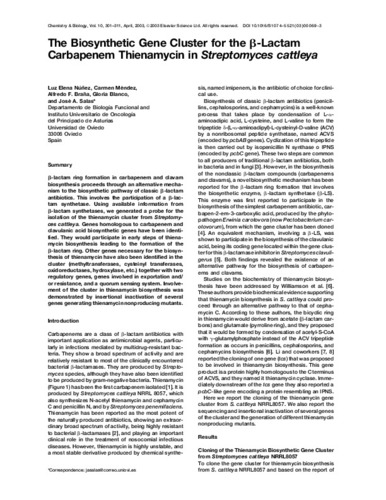The biosynthetic gene cluster for the β-lactam carbapenem thienamycin in Streptomyces cattleya
Fecha de publicación:
Editorial:
Elsevier Science
Versión del editor:
Citación:
Descripción física:
Resumen:
β-lactam ring formation in carbapenem and clavam biosynthesis proceeds through an alternative mechanism to the biosynthetic pathway of classic β-lactam antibiotics. This involves the participation of a β-lactam synthetase. Using available information from β-lactam synthetases, we generated a probe for the isolation of the thienamycin cluster from Streptomyces cattleya. Genes homologous to carbapenem and clavulanic acid biosynthetic genes have been identified. They would participate in early steps of thienamycin biosynthesis leading to the formation of the β-lactam ring. Other genes necessary for the biosynthesis of thienamycin have also been identified in the cluster (methyltransferases, cysteinyl transferases, oxidoreductases, hydroxylase, etc.) together with two regulatory genes, genes involved in exportation and/or resistance, and a quorum sensing system. Involvement of the cluster in thienamycin biosynthesis was demonstrated by insertional inactivation of several genes generating thienamycin nonproducing mutants
β-lactam ring formation in carbapenem and clavam biosynthesis proceeds through an alternative mechanism to the biosynthetic pathway of classic β-lactam antibiotics. This involves the participation of a β-lactam synthetase. Using available information from β-lactam synthetases, we generated a probe for the isolation of the thienamycin cluster from Streptomyces cattleya. Genes homologous to carbapenem and clavulanic acid biosynthetic genes have been identified. They would participate in early steps of thienamycin biosynthesis leading to the formation of the β-lactam ring. Other genes necessary for the biosynthesis of thienamycin have also been identified in the cluster (methyltransferases, cysteinyl transferases, oxidoreductases, hydroxylase, etc.) together with two regulatory genes, genes involved in exportation and/or resistance, and a quorum sensing system. Involvement of the cluster in thienamycin biosynthesis was demonstrated by insertional inactivation of several genes generating thienamycin nonproducing mutants
Patrocinado por:
This research has been supported by a grant of the Ministery of 16. Kuzuyama, T., Seki, T., Dairi, T., Hidaka, T., and Seto, H. (1995). Science and Technology (1FD97-0799) and grants of the Plan Re- Nucleotide sequence of fortimicin KL1 methyltransferase gene gional de Investigacio´ n del Principado de Asturias (GE-MEDO1-05 isolated from Micromonospora olivasterospora, and compariand FC-02-PC-REC01-20). L.E.N. was the recipient of a MIT grant son of its deduced amino acid sequence with those of methylfrom the Spanish Ministery of Science and Technology
Colecciones
- Artículos [37549]
- Biología Funcional [807]
Ficheros en el ítem




